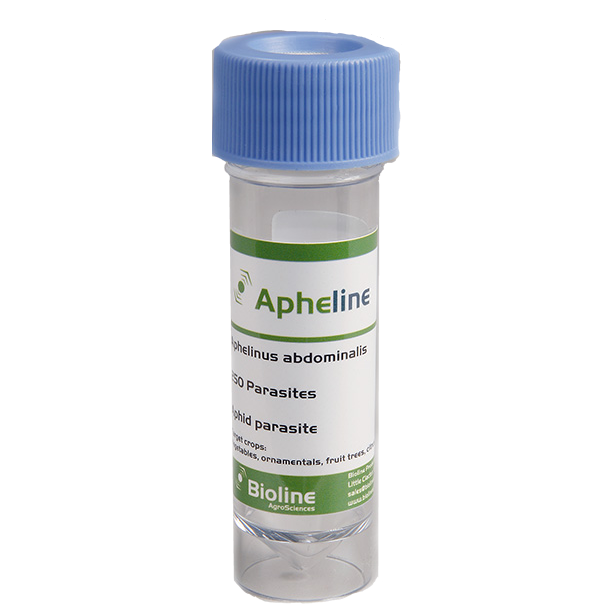Potato aphids (Macrosiphum euphorbiae);
Foxglove (Aulacorthum solani);
Rose aphid (Macrosiphum rosae);
Green peach aphid (Myzus persicae);
Blue alfalfa aphid (Acyrthosiphum kondoi);
Peanut aphid (Aphis craccivora);
Mustard aphid (Lipaphis erysimi);
Rose-grain aphid (Metopolophium dirhodum);
Aphid (Aulacorthum circleflexum);
Bird cherry-oat aphid (Rhopalosiphum padi);
Wheat aphid (Schizaphis graminum);
Grain aphid (Sitobion avenae).
Tomato, pepper, eggplant, melon, watermelon, rose, grape, gerbera, strawberry, legume.
Mummy/imago 30 ml bottle contains 250/500 insects;
Mummy/imago 250 ml bottle contains 250/500 insects.
A. abdominalis is a wasp, the female is about 3mm long and black with a yellowish-brown abdomen. The legs and antennae are relatively short. Although winged, they are not strong fliers. Males are slightly smaller and darker.
The females fly rarely; they prefer to walk carefully looking for the aphids. Having discovered the victim, beneficial insects lay eggs unnoticing within 20-60 seconds. Consistent behavior increases the effectiveness of A. abdominalis. Within 24 hours the female can infect between 5 and 10 aphids, under favorable conditions its total fertility is 140 eggs, during the season this insect can give from 6 to 9 generations.
A. abdominalis can parasitize at all aphid developmental instars but prefers 2d and 3d instar ones. When the egg hatches into larvae inside the aphid nymph, the aphid swells and hardens into a leathery, grey, or brown colored mummy. After 7 days the infected aphid transforms into a distinctive black mummy. After 8 days the adult appears and lays eggs actively. Besides parasitism, the imago behaves like a predator, it pierces the aphid covers and feeds on the hemolymph, and then the aphid dies.
The duration of all ontogenesis stages (from the embryo to the birth of an imago) depends on temperature:
| Beneficial insects | +13…15 °С | +15…17 °С | +19…21 °С | +27…29 °С |
|---|---|---|---|---|
| Aphelinus abdominalis | up to 28 days | up to 26 days | up to 22 days | up to 15 days |
When the ambient temperature drops below +13°C, some larvae enter the diapause during the pupation period. Wintering mummies are natural adaptations of the species to the season changes. Wintering mummies can withstand the temperature up to -39 °C.
Use A. abdominalis in crops directly to prevent outbreaks of various aphid species. In the case of high pest density, A.abdominalis is often used in combination with other bio agents (Aphidius ervi, Aphidoletes aphidimyza and others).
You should remove yellow traps as far from the releasing point of the flying parasitoid as possible. At the moment of flying from the vial, there is a possibility that the wasp will fly on a sticky trap, bright light, or simply up and run outside through an open window. Therefore, the release is the best to carry out in the afternoon before sunset or early morning at dawn.
| The bioagent name in Latin | Doses of the application by a degree of infection | ||
|---|---|---|---|
| Small | Average | High | |
| Aphelinus abdominalis | 0,3-0,5 ind/m2 | 1-3 ind/m2</sup | 3-5 ind/m2</sup |

Оставить комментарий